Computer equipment
Computer equipment

Title: Computer Equipment: Enhancing Efficiency and Productivity
Introduction:
Computer equipment plays a vital role in today's digital era, where technology has become an integral part of our daily lives. From personal computers to servers and data centers, these devices and systems have revolutionized the way we work, communicate, and access information. In this article, we will explore the significance of computer equipment, its various types, and how it enhances efficiency and productivity across different sectors.
Types of Computer Equipment:
Computer equipment encompasses a wide range of devices and systems that facilitate computing tasks. Here are some essential types:
Personal Computers (PCs):
Personal computers are the most common type of computer equipment used by individuals, businesses, and educational institutions. PCs consist of a CPU (Central Processing Unit), monitor, keyboard, and mouse. With advancements in technology, PCs now come in various forms, including desktops, laptops, and tablets. These devices empower users to perform tasks like word processing, multimedia editing, web browsing, and much more.
Servers and Data Centers:
Servers and data centers form the backbone of modern computing infrastructure. Servers are powerful computers designed to provide resources and services to other computers on a network. They handle tasks such as hosting websites, managing databases, and delivering applications. Data centers house a large number of servers and network equipment, enabling organizations to store, process, and distribute vast amounts of data efficiently.
Networking Equipment:
Networking equipment, such as routers, switches, and modems, enables the establishment of computer networks. Routers connect multiple networks, facilitating data transmission between devices. Switches connect devices within a network, enabling efficient data transfer. Modems allow computers to connect to the internet via telephone lines, cable lines, or wireless networks. Networking equipment is crucial for seamless communication and data sharing across devices and networks.
Peripherals and Accessories:
Peripherals and accessories enhance the functionality of computer systems. These include devices like printers, scanners, external storage devices (e.g., hard drives and flash drives), webcams, speakers, and projectors. These peripherals expand the capabilities of computers and enable users to perform specific tasks, such as printing documents, capturing images, and delivering presentations.
Enhancing Efficiency and Productivity:
Computer equipment significantly enhances efficiency and productivity across various sectors. Here are a few examples:
Business and Workplaces:
In the business world, computer equipment streamlines operations, improves communication, and optimizes productivity. PCs and laptops allow employees to access and process information, collaborate on projects, and communicate with colleagues efficiently. Servers and data centers enable businesses to store and manage vast amounts of data securely. Networking equipment ensures seamless connectivity, allowing teams to collaborate across different locations. Peripherals like printers and scanners facilitate document management and sharing.
Education and Research:
Computer equipment has transformed the education landscape, making learning more interactive and accessible. Students can conduct research, access digital libraries, and collaborate with peers and educators. Computers enable the creation of engaging multimedia content, e-learning platforms, and virtual classrooms. Powerful servers and data centers support online learning management systems, enabling educational institutions to handle large student populations efficiently.
Creative Industries:
In creative fields such as graphic design, animation, video editing, and music production, computer equipment is essential for unleashing artistic potential. High-performance PCs with dedicated graphics cards and large storage capacity are used for resource-intensive tasks. Peripherals like drawing tablets, high-resolution monitors, and professional-grade audio equipment enhance the creative workflow, enabling professionals to produce stunning visuals, animations, and audio compositions.
Scientific and Technical Research:
Computer equipment plays a crucial role in scientific and technical research, where complex simulations, data analysis, and modeling are common. Supercomputers, often housed in specialized data centers, provide immense processing power for tasks like climate modeling,





Comments
There are no comments for this story
Be the first to respond and start the conversation.